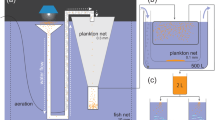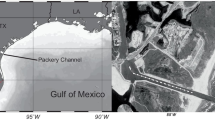Abstract
Different microalgae as larval food for Holothuria scabra, a high-value sea cucumber species with hatchery technology continually being refined to improve production, were studied. Two experiments were conducted to determine the performance of the larvae—first, the use of single-algal diet of either Chaetoceros calcitrans, Rhodomonas sp., or Tetraselmis tetrathele as feed; and second, the use of a combination of two algal species, C. calcitrans + Rhodomonas sp., C. calcitrans + T. tetrathele, or Rhodomonas sp. + T. tetrathele as feed. For both experiments, hatched larvae at 2 days post-fertilization (DPF) were used for initial stocking at a density of 200 larvae L−1. Growth, development, and survival were monitored until more than 50% of the larval population were considered as competent larvae (late auricularia). In the first experiment, during the early stage of development (early aricularia), larvae fed Rhodomonas sp. were larger compared to other treatments. However, when the larvae reached middle and late auricularia, they performed better when fed with C. calcitrans. Those larvae fed with C. calcitrans were significantly larger and showed faster development to competent larvae. In the second experiment, larvae fed mixed C. calcitrans + Rhodomonas sp. showed better performance in growth, development, and survival. The present study showed that C. calcitrans, when used solely as feed or in combination with Rhodomonas sp., promoted better growth, development, and survival of H. scabra larvae.




Similar content being viewed by others
Data availability
The datasets generated during and/or analyzed during the current study are available from the corresponding author on reasonable request.
References
Agudo NS (2006) Sandfish hatchery techniques. Secretariat of the Pacific Community, New Caledonia
Anderson SC, Flemming JM, Watson R, Lotze HK (2010) Serial exploitation of global sea cucumber fisheries. Fish Fish 12:1–23
Asha PS, Muthiah P (2006) Effects of single and combined microalgae on larval growth, development and survival of the commercial sea cucumber Holothuria spinifera Theel. Aquac Res 37:113–118
Battaglene SC (1999) Culture of tropical sea cucumbers for stock restoration and enhancement. Naga, the ICLARM Quarterly 22:4-11
Bruckner AW, Johnson KA, Field JD (2003) Conservation strategies for sea cucumbers: can a CITES Appendix II Listing promote sustainable international trade? SPC Beche-de-mer Inf Bull 18:24–33
Chen CP, Chian CS (1990) Larval development of the sea cucumber Actinopyga echinites (Echinodermata: Holothuroidea). Bull Inst Zool Acad Sin 29:127–133
Chen CP, Hsu HW, Deng DC (1991) Comparison of larval development and growth of the sea cucumber Actinopyga echinites: ovary-induced ova and DTT-induced ova. Mar Biol 109:453–457
Conand C (2004) Present status of world sea cucumber resources and utilization: an international overview. In: Lovatelli A, Conand C, Purcell S, Uthicke S, Hamel JF, Mercier A (eds) Advances in sea cucumber aquaculture and management. Rome, FAO, pp 13–23
Dabbagh AR, Sedaghat MR (2012) Breeding and rearing of the sea cucumber Holothuria scabra in Iran. SPC Beche-de-mer Inf Bull 32:49–52
de la Peña MR, Franco AV (2013) Culture of marine phytoplankton for aquaculture seed production. Aquaculture Department, Southeast Asian Fisheries Development Center, Iloilo
de la Peña MR, Villegas CT (2005) Cell growth, effect of filtrate and nutritive value of the tropical prasinophyte Tetraselmis tetrathele (Butcher) at different phases of culture. Aquac Res 36:1500–1508
Dominguez-Godino JA, Slater MJ, Hannon C, Gonzalez-Wanguermert M (2015) A new species for sea cucumber ranching and aquaculture: breeding and rearing of Holothuria arguinensis. Aquaculture 438:122–128
Dunstan GA, Brown MR, Volkman JK (2005) Cryptophyceae and Rhodophyceae; chemotaxonomy, phylogeny, and application. Phytochemistry 66:2557–2570
Duy NDQ (2010) Seed production of sandfish (Holothuria scabra) in Vietnam. Aquaculture Department, Southeast Asian Fisheries Development Center, Iloilo
Duy NDQ (2012) Large-scale sandfish production from pond culture in Vietnam. In: Hair CA, Pickering TD, Mills DJ (eds) Asia-Pacific tropical sea cucumber aquaculture. ACIAR, Canberra, pp 34–39
Duy NDQ, Pirozzi I, Southgate PC (2015) Ingestion and digestion of live microalgae and microalgae concentrates by sandfish, Holothuria scabra, larvae. Aquaculture 448:256–261
Duy NDQ, Francis DS, Pirozzi I, Southgate PC (2016a) Use of micro-algae concentrates for hatchery culture of sandfish, Holothuria scabra. Aquaculture 464:145–152
Duy NDQ, Pirozzi I, Southgate PC (2016b) Development of hyaline spheres in late auricularia of sandfish, Holothuria scabra: is it a reliable indicator of subsequent performance? Aquaculture 465:144–151
Fernandez-Reiriz M, Perez-Carmelo A, Ferreiro M, Blanco J, Planas M, Campos MJ, Labarta U (1989) Biomass production and variation in the biochemical profile (total protein, carbohydrates, RNA, lipids and fatty acids) of seven species of marine microalgae. Aquaculture 83:17–37
Gamboa R, Gomez AL, Nievales MF (2004) The status of sea cucumber fishery and mariculture in the Philippines. In: Lovatelli A, Conand C, Purcell S, Uthicke S, Hamel JF, Mercier A (eds) Advances in sea cucumber aquaculture and management. FAO, Rome, pp 69–78
Gamboa RU, Aurelio RM, Ganad DA, Concepcion LB, Abreo NAS (2012) Small-scale hatcheries and simple technologies for sandfish (Holothuria scabra) production. In: Hair CA, Pickering TD, Mills DJ (eds) Asia-Pacific tropical sea cucumber aquaculture. ACIAR, Canberra, pp 63–74
Giraspy DAB, Ivy G (2005) Australia’s first commercial sea cucumber culture and sea ranching project in Hervey Bay, Queensland, Australia. SPC Beche-de-mer Inf Bull 21:29–31
Giraspy DAB, Walsalam GI (2010) Aquaculture potential of the tropical sea cucumbers Holothuria scabra and H. lessoni in the Indo-Pacific Region. SPC Beche-de-mer Inf Bull 30:29–32
Guisado C, Carrasco SA, Diaz-Guisado D, Maltrain R, Rojas H (2012) Embryonic development, larval morphology and juvenile growth of the sea cucumber Athyonidium chilensis (Holothuroidea:Dendrochirotida). Rev Biol Mar Oceanogr 47:65–73
Hu C, Li H, Xia J, Zhang L, Luo P, Fan S, Peng P, Yang H, Wen J (2013) Spawning, larval development and juvenile growth of the sea cucumber Stichopus horrens. Aquaculture 405:47–54
Huerlimann R, de Nys R, Heimann K (2010) Growth, lipid content, productivity, and fatty acid composition of tropical microalgae for scale-up production. Biotechnol Bioeng 107:245–257
Huiling S, Mengquing L, Jingping Y, Bijuan C (2004) Nutrient requirements and growth of sea cucumber, Apostichopus japonicus. In: Lovatelli A, Conand C, Purcell S, Uthicke S, Hamel JF, Mercier A (eds) Advances in sea cucumber aquaculture and management. FAO, Rome, pp 327–331
Ito S, Kitamura H (1997) Induction of larval metamorphosis in the sea cucumber Stichopus japonicus by periphetic diatoms. Hydrobiologia 358:281–284
Ivy G, Giraspy DAB (2006) Development of large-scale hatchery production techniques for the commercially important sea cucumber Holothuria scabra veriscolor (Conand, 1986) in Queensland, Australia. SPC Beche-de-mer Inf Bull 24:28–34
James DB (2004) Captive breeding of the sea cucumber, Holothuria scabra, from India. In: Lovatelli A, Conand C, Purcell S, Uthicke S, Hamel JF, Mercier A (eds) Advances in sea cucumber aquaculture and management. FAO, Rome, pp 347–358
James DB, Gandhi AD, Palaniswamy N, Rodrigo JX (1994) Hatchery techniques and culture of the sea cucumber Holothuria scabra. Central Marine Fisheries Research Institute Special Publication 57:1-40
Knauer J (2011) Growth and survival of larval sandfish, Holothuria scabra (Echinodermata: Holothuroidea), fed different microalgae. J World Aquacult Soc 42:880–887
Kumara PADA, Jayanatha JS, Pushpakumara J, Bandara W, Dissanayake DCT (2013) Artificial breeding and larval rearing of three tropical sea cucumber species - Holothuria scabra, Pseudocolochirus violaceus and Colochirus quadrangularis in Sri Lanka. SPC Beche-de-mer Inf Bull 33:30–37
Lafarga-de la Cruz F, Valenzuela-Espinoza E, Millan-Nuñez R, Trees CC, Santamaria-del Angel E, Nuñez-Cebrero F (2006) Nutrient uptake, chlorophyll ɑ and carbon fixation by Rhodomonas sp. (Cryptophyceae) cultured at different irradiance and nutrient concentrations. Aquac Eng 35:51–60
Militz TA, Leini E, Duy NDQ, Southgate PC (2018) Successful large-scale hatchery culture of sandfish (Holothuria scabra) using micro-algae concentrates as larval food source. Aquac Rep 9:25–30
Millamena OM, Peñaflorida VD, Subosa PF (1990) The macronutrient composition of natural food organisms mass cultured as larval feed for fish and prawns. Isr J Aquac 42:77–83
Morgan AD (2001) The effect of food availability on early growth, development and survival of the sea cucumber Holothuria scabra (Echinodermata:Holothuroidea). SPC Beche-de-mer Inf Bull 14:6–12
Morgan AD (2009) Assessment of egg and larval quality during hatchery production of the temperate sea cucumber, Australostichopus mollis (Levin). J World Aquacult Soc 40:629–642
Patil V, Kallqvist T, Olsen E, Vogt G, Gislerod H (2007) Fatty acid composition of 12 microalgae for possible use in aquaculture feed. Aquac Int 15:1–9
Pitt R, Duy NDQ (2003) Breeding and culture of the sea cucumber Holothuria scabra in Vietnam. Aquac Asia 8:36–37
Pitt R, Duy NDQ (2004) Breeding and rearing of the sea cucumber Holothuria scabra in Viet Nam. In: Lovatelli A, Conand C, Purcell S, Uthicke S, Hamel JF, Mercier A (eds) Advances in sea cucumber aquaculture and management. FAO, Rome, pp 333–346
Purcell SW, Hair CA, Mills DJ (2012) Sea cucumber culture, farming and sea ranching in the tropics: progress, problems and opportunities. Aquaculture 368-369:68–81
Ramofafia C, Gervis M, Bell J (1995) Spawning and early larval rearing of Holothuria atra. SPC Beche-de-mer Inf Bull 7:2–6
Ramofafia C, Byrne M, Battaglene SC (2003) Development of three commercial sea cucumbers, Holothuria scabra, H. fuscogilva and Actinopyga mauritiana: larval structure and growth. Mar Freshw Res 54:657–667
Renaud SM, Thinh LV, Parry DL (1999) The gross chemical composition and fatty acid composition of 18 species of tropical Australian microalgae for possible use in mariculture. Aquaculture 170:147–159
Ronquillo JD, Matias JR, Saisho T, Yamasaki S (1997) Culture of Tetraselmis tetrathele and its utilization in the hatchery production of different penaeid shrimps in Asia. Hydrobiologia 358:237–244
Seixas P, Coutinho P, Ferreira M, Otero A (2009) Nutritional value of the cryptophyte Rhodomonas lens for Artemia sp. J Exp Mar Biol Ecol 381:1–9
Shamsudin L (1992) Lipid and fatty acid composition of microalgae used in Malaysian aquaculture as live food for the early stages of penaeid larvae. J Appl Phycol 4:371–378
Thompson PA, Harrison PJ, Whyte JNC (1990) Influence of irradiance on the fatty acid composition of phytoplankton. J Phycol 26:278–288
Tremblay R, Cartier S, Miner P, Pernet F, Quere C, Moal J, Muzellec ML, Mazuret M, Samain JF (2007) Effect of Rhodomonas salina addition to a standard hatchery diet during the early ontogeny of the scallop Pecten maximus. Aquaculture 262:410–418
Whyte JNC (1987) Biochemical composition and energy content of six species of phytoplankton used in mariculture of bivalves. Aquaculture 60:231–241
Zacarias-Soto M, Olvera-Novoa MA, Pensamiento-Villarauz S, Sanchez-Tapia I (2013) Spawning and larval development of the four-sided sea cucumber, Isostichopus badionotus (Selenka 1867) under controlled conditions. J World Aquacult Soc 44:694–705
Acknowledgements
The authors would like to thank the Southeast Asian Fisheries Development Center, Aquaculture Department, for the use of facilities and for providing the microalgae and H. scabra larvae during the conduct of the experiments; Mr. Neil Tibubos, Mr. Jesus Rodriguez Jr., and Mr. Romeo Tibudan for their kind assistance during the conduct of the experiments; and the anonymous journal reviewers for patiently reviewing the manuscript.
Author information
Authors and Affiliations
Corresponding author
Additional information
Publisher’s note
Springer Nature remains neutral with regard to jurisdictional claims in published maps and institutional affiliations.
Rights and permissions
About this article
Cite this article
Sibonga, R.C., Laureta, L.V., Lebata-Ramos, M.J.H. et al. Single and mixed species of microalgae as larval food for the tropical sea cucumber Holothuria scabra. J Appl Phycol 33, 3103–3112 (2021). https://doi.org/10.1007/s10811-021-02512-1
Received:
Revised:
Accepted:
Published:
Issue Date:
DOI: https://doi.org/10.1007/s10811-021-02512-1




